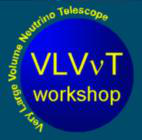Description
Chairs: Gerard van der Steenhoven (NIKHEF): Morning session, John Carr (CPPM): Afternoon session
Brendan FOX
(Pennsylvania State University)
24/04/2008 09:00
Following up on the success of the AMANDA detector, the IceCube experiment is building the first of the next generation, cubic kilometer neutrino telescopes at the South Pole. This effort is now half way towards completion. This talk will focus on the technical aspects of the project: namely, the construction, the commissioning, and the technical data analysis work that has been and is...
Vladimir AYNUDTINOV
(INR RAS)
24/04/2008 09:30
A full-scale prototype string for the future km3-scale neutrino telescope has been deployed in April, 2008 and is fully intergrated into the NT200+ telescope. All basic string elements - optical modules, 200MHz FADC readout and calibration system - have been redesigned following experience with NT200+. First results of in-situ operation of this prototype string are presented.
Dmitri SEMIKOZ
(APC Paris)
24/04/2008 09:50
In this talk I'll present theoretical predictions of the diffuse neutrino fluxes constrained by the cosmic ray and gamma-ray data. Also I'll review possible classes of the point-like high energy neutrino sources and discuss perspectives of their detection.
Vincent RIGAUD
(IFREMER, Centre de Brest, France)
24/04/2008 10:20
Plenary talk
Installation and maintenance of Subsea observatories and very large telescopes require access to workhorse marine vessels and underwater systems. The cost of possession of such infrastructures is highly dependent to their rate of usage. Such rate of usage could be optimised by the multipurpose use of the infrastructure, or by full rate of usage. Other possibilities are Bartering, chartering...
Ingrid PUILLAT
(IFREMER Centre de Brest, France)
24/04/2008 11:10
ESONET is a Multidisciplinary European Network of Excellence (NoE) associating 50 partners from 14 countries and more than 300 scientists and engineers and dedicated to the lasting integration of research and development in deep sea observatories in Europe. Amongst other actions, it works at establishing seafloor infrastructure that will provide platforms for instrumentation deployed...
Ronan MICHEL
(Alcatel-Lucent Submarine Networks)
24/04/2008 11:40
Pascal VERNIN
(CEA Saclay, Paris)
24/04/2008 12:00
ABSTRACT: In the Antares detector the link between the Junction Box and each of the line anchors is made by a cable (2 electrical conductors + 4 monomode optical fibers) equipped at both ends by a pair of underwater matable connector. The connection is performed by a ROV. I will summarize the experience gained in Antares with this key equipment.
Robert LAHMANN
(University of Erlangen)
24/04/2008 14:00
The use of conventional neutrino telescope methods and technology for detecting neutrinos with ultra-high energies from astrophysical sources would be prohibitively expensive and may turn out to be technically not feasable. Acoustic detection is a promising option for future deep-sea neutrino telescopes operating in this energy regime. It utilises the effect that a cascade evolving from a...
Michel ANDRE
(Laboratori d'Aplicacions Bioacústiques (LAB), Universitat Politècnica de Catalunya (UPC))
24/04/2008 14:20
Noise pollution in the marine environment is an emerging but serious concern. Its implications are less well understood than other global threats and largely undetectable to everyone but the specialist. In addition, the assessment of the acoustic impact of artificial sounds in the sea is not a trivial task, certainly because there is a lack of information on how the marine organisms process...
Thierry Pradier
(IPHC Strasbourg)
24/04/2008 14:50
Both gravitational waves (GW) sources and high energy (HE) neutrino emitters involve compact objects and matter moving at relativistic speeds. Moreover, GW emission requires departure from spherical symmetry, which is the case if clumps of matter are accreted around black holes, and blobs of plasma are ejected in astrophysical jets, where HE neutrinos are believed to be produced. Both...
Stephane BASA
(LAM Marseille)
24/04/2008 15:20
GRBs are the most energetic events in the Universe, associated with the death of massive stars (core-collapse supernovae), or the merging of neutron stars or black holes. Discovered in the late 1960s, their cosmological origin was demonstrated only in 1997 when the first distance (redshift) of a GRB was measured. Theoretical models predict that the very energetic processes at work in GRBs...
Prof.
Steve BARWICK
(UC Irvine)
24/04/2008 16:10
Dedicated high energy neutrino telescopes based on optical Cherenkov techniques have been scanning the cosmos for about a decade. At TeV scales, limits on the diffuse flux have improved by several orders of magnitude, eliminating the most optimistic models that tend to be normalized to the extragalactic x-ray and gamma-ray backgrounds. At higher energies, neutrino telescopes have provided...
Dr
Greg Hallewell
(CPPM)
24/04/2008 17:10

